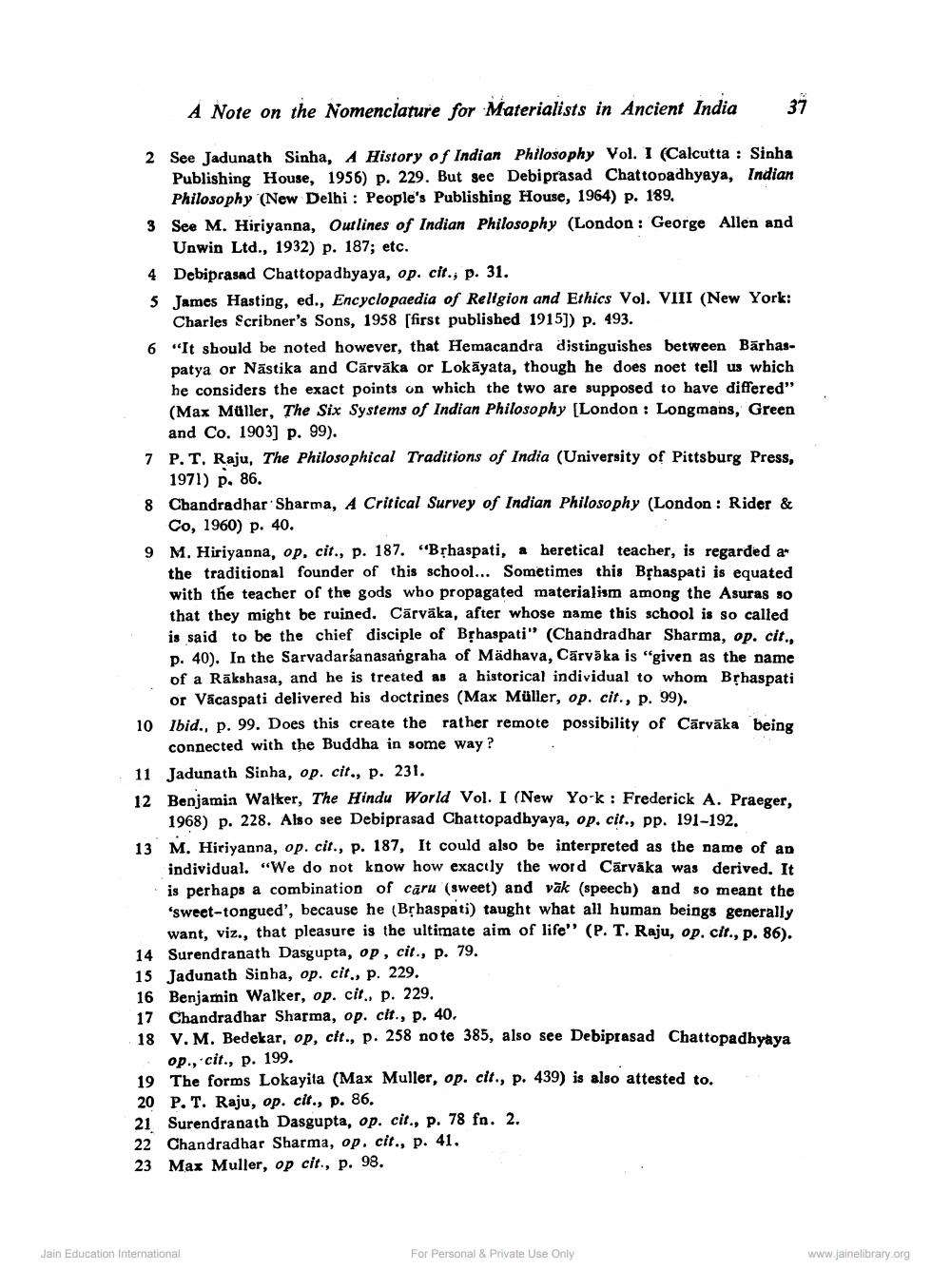________________
A Note on the Nomenclature for Materialists in Ancient India
37
2 See Jadunath Sinha, A History of Indian Philosophy Vol. I (Calcutta : Sinha
Publishing House, 1956) p. 229. But see Debi prasad Chattopadhyaya, Indian
Philosophy (New Delhi: People's Publishing House, 1964) p. 189. 3 See M. Hiriyanna, Outlines of Indian Philosophy (London: George Allen and
Unwin Ltd., 1932) p. 187; etc. 4 Debiprasad Chattopadhyaya, op. cit., p. 31. 5 James Hasting, ed., Encyclopaedia of Religion and Ethics Vol. VIII (New York:
Charles Scribner's Sons, 1958 [first published 1915]) p. 493. 6 "It should be noted however, that Hemacandra distinguishes between Bärhas
patya or Nāstika and Cārvāka or Lokāyata, though he does noet tell us which he considers the exact points on which the two are supposed to have differed" (Max Müller, The Six Systems of Indian Philosophy (London: Longmans, Green
and Co. 1903) p. 99). 7 P. T. Raju, The Philosophical Traditions of India (University of Pittsburg Press,
1971) p. 86. 8 Chandradhar Sharma, A Critical Survey of Indian Philosophy (London: Rider &
Co, 1960) p. 40. 9 M. Hiriyanna, op. cit., p. 187. "Brhaspati, a heretical teacher, is regarded as
the traditional founder of this school... Sometimes this Bphaspati is equated with the teacher of the gods who propagated materialism among the Asuras so that they might be ruined. Cārvāka, after whose name this school is so called is said to be the chief disciple of Bşhaspati" (Chandradhar Sharma, op. cit.. D. 40). In the Saryadarśanasangraha of Madhava, Carväka is "given as the name of a Rakshasa, and he is treated as a historical individual to whom Brhaspati
or Vācaspati delivered his doctrines (Max Müller, op. cit., p. 99). 10 lbid., p. 99. Does this create the rather remote possibility of Cārvāka being
connected with the Buddha in some way? 11 Jadunath Sinha, op. cit., p. 231. 12 Benjamin Walker, The Hindu World Vol. I (New York: Frederick A. Praeger,
1968) p. 228. Also see Debiprasad Chattopadhyaya, op. cit., pp. 191-192. 13 M. Hiriyanna, op. cit., p. 187, It could also be interpreted as the name of an
individual. "We do not know how exactly the word Cārvāka was derived. It is perhaps a combination of caru (sweet) and vāk (speech) and so meant the 'sweet-tongued', because he (Brbaspati) taught what all human beings generally
want, viz., that pleasure is the ultimate aim of life" (P. T. Raju, op. cit., p. 86). 14 Surendranath Dasgupta, op. cit., p. 79. 15 Jadunath Sinha, op. cit., p. 229. 16 Benjamin Walker, op. cit., p. 229. 17 Chandradhar Sharma, op. cit., p. 40. 18 V.M. Bedekar, op. cit., p. 258 note 385, also see Debiprasad Chattopadhyava
op., cit., p. 199. 19 The forms Lokayita (Max Muller, op. cit., p. 439) is also attested to. 20 P.T. Raju, op. cit., p. 86. 21 Surendranath Dasgupta, op. cit., p. 78 fq. 2. 22 Chandradhar Sharma, op. cit., p. 41. 23 Max Muller, op cit., p. 98.
Jain Education International
For Personal & Private Use Only
www.jainelibrary.org




